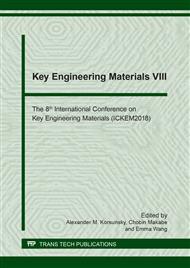[1]
O. Gencel, A. Bozkurt, E. Kam, T. Korkut, Determination and calculation of gamma and neutron shielding characteristics of concretes containing different hematite proportions, Ann. Nucl. Energy. 38 (2011) 2719–2723.
DOI: 10.1016/j.anucene.2011.08.010
Google Scholar
[2]
I. Akkurt, C. Başyiğit, A. Akkaş, S. Kilinçarsian, B. Mavi, K. Günoğlu, Determination of some heavyweight aggregate half value layer thickness used for radiation shielding, Acta. Phys. Pol. A. 121 (2012) 138–140.
DOI: 10.12693/aphyspola.121.138
Google Scholar
[3]
I. Akkurt, H. Akyildirim, B. Mavi, S. Kilinçarsian, C. Basyigit, Photon attenuation coefficients of concrete includes barite in different rate, Ann. Nucl. Energy. 37 (2010) 910–914.
DOI: 10.1016/j.anucene.2010.04.001
Google Scholar
[4]
I. Akkurt, H. Akyildirim, B. Mavi, S. Kilinçarsian, C. Basyigit, Radiation shielding of concrete containing zeolite, Radiat. Meas. 45 (2010) 827–830.
DOI: 10.1016/j.radmeas.2010.04.012
Google Scholar
[5]
E. Yilmaz, H. Baltas, E. Kiris, I. Ustabas, U. Cevik, A.M. El-khayatt, Gamma ray and neutron shielding properties of some concrete materials, Ann. Nucl. Energy. 38 (2011) 2204–2212.
DOI: 10.1016/j.anucene.2011.06.011
Google Scholar
[6]
M.H. Kharita, M. Takeyeddin, M. Alnassar, S. Youse, Development of special radiation shielding concretes using natural local materials and evaluation of their shielding characteristics, Prog. Nucl. Energy. 50 (2008) 33-36.
DOI: 10.1016/j.pnucene.2007.10.004
Google Scholar
[7]
I.I. Bashter, Calculation of radiation attenuation coefficients for shielding concretes, Ann. Nucl. Energy. 24 (1997) 1389-1401.
DOI: 10.1016/s0306-4549(97)00003-0
Google Scholar
[8]
I. Akkurt, C. Başyiğit, S. Kilinçarsian, B. Mavi, The shielding of γ-rays by concretes produced with barite, Prog. Nucl. Energy. 46 (2005) 1-11.
DOI: 10.1016/j.pnucene.2004.09.015
Google Scholar
[9]
ASTM C127 – 15. Standard Test Method for Relative Density (Specific Gravity) and Absorption of Coarse Aggregate. (2015).
Google Scholar
[10]
ASTM C128 – 15. Standard Test Method for Relative Density (Specific Gravity) and Absorption of Fine Aggregate. (2015).
Google Scholar
[11]
ASTM C131. Standard Test Method for Resistance to Degradation of Small-Size Coarse Aggregate by Abrasion and Impact in the Los Angeles Machine. (2001).
DOI: 10.1520/c0131_c0131m-14
Google Scholar
[12]
ASTM C88-13. Standard Test Method for Soundness of Aggregates by Use of Sodium Sulfate or Magnesium Sulfate. (2013).
DOI: 10.1520/c0088-05
Google Scholar
[13]
ASTM C1260 – 14. Standard Test Method for Potential Alkali Reactivity of Aggregates (Mortar-Bar Method). (2014).
DOI: 10.1520/c1260-01
Google Scholar
[14]
L. Gerward, N. Guilbert, K.B. Jensen, H. Levring, WinXCom-a program for calculating X-ray attenuation coefficients, Radiat. Phys. Chem. 71 (2004) 653-654.
DOI: 10.1016/j.radphyschem.2004.04.040
Google Scholar
[15]
R. Şahin, R. Polat, O. İçelli, C. Çelik, Determination of transmission factors of concretes with different water/cement ratio, curing condition, and dosage of cement and air entraining agent, Ann. Nucl. Energy. 38 (2011) 1505–1511.
DOI: 10.1016/j.anucene.2011.03.013
Google Scholar
[16]
ASTM C637. Standard Specification for Aggregates for Radiation-shielding Concrete. (2009).
Google Scholar
[17]
A.S. Ouda, Development of high-performance heavy density concrete using different aggregates for gamma-ray shielding, Prog. Nucl. Energy. 79 (2015) 48-55.
DOI: 10.1016/j.pnucene.2014.11.009
Google Scholar
[18]
A. Un, F. Demir, Determination of mass attenuation coefficients, effective atomic numbers and effective electron numbers for heavy-weight and normal-weight concretes, Appl. Radiat. Isot. 80 (2013) 73-77.
DOI: 10.1016/j.apradiso.2013.06.015
Google Scholar
[19]
Information on http://www.nist.gov/pml/data/xcom/index.cfm.
Google Scholar
[20]
P. Limkitjaroenporn, J. Kaewkhao, P. Limsuwan, W. Chewpraditkul, Physical, optical, structure and gamma-ray shielding properties of lead sodium borate glasses, Phys. Chem. Solids. 72 (2011) 245-251.
DOI: 10.1016/j.jpcs.2011.01.007
Google Scholar
[21]
R. S. Rajavikraman, Novel Method for Radiation Shielding Using Nano-Concrete Composite, International Journal of Materials Science and Engineering. 1 (2013) 20-23.
DOI: 10.12720/ijmse.1.1.20-23
Google Scholar


